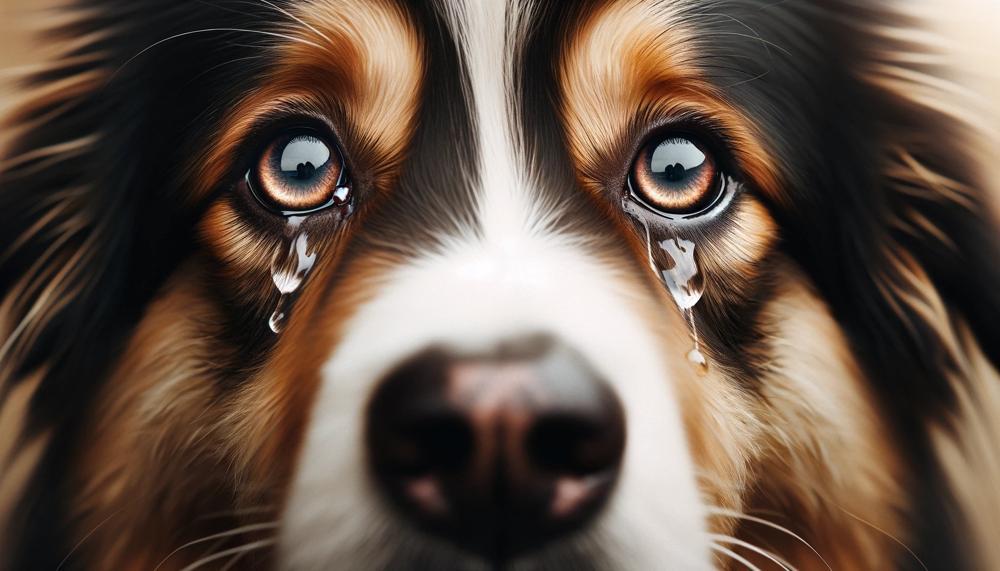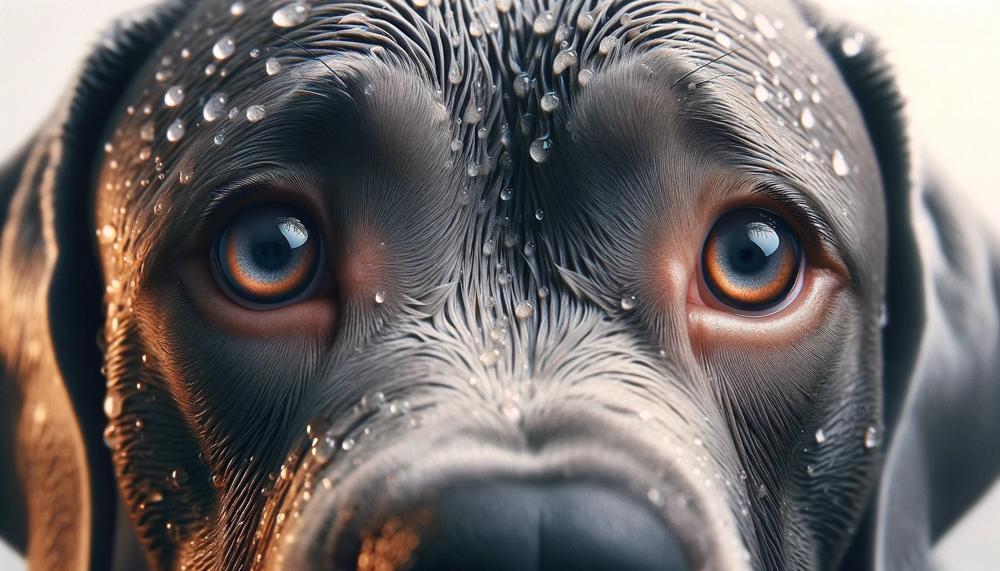As pet parents, we always strive to keep our furry friends in the best shape possible. But when we notice something unusual, like our dog’s eyes watering more than usual, it can be worrisome. Before you start panicking and heading straight to the vet, let’s take a closer look at what could be causing this issue.
There are various reasons why your dog’s eyes may be watery, ranging from simple allergies to more serious underlying health conditions. It’s important to pay attention to your pup’s symptoms and behavior in order to determine the root cause and provide appropriate treatment.
In this blog post, we’ll dive into the potential causes of watery eyes in dogs and share valuable insights on how to effectively manage this issue.
So, why are my dogs eyes watery?
Here are some reasons why a dog’s eyes might be watery:
- Allergies: The most common cause of watery eyes in dogs. Dogs with allergies will usually have discharge from both eyes, but some dogs may only have one watery eye at a time.
- Dry eye: Immune system problems are the cause of most cases of dry eye in dogs. Other symptoms include redness, pain, itching, and cloudy eyes.
- Glaucoma: An eye disease that causes increased pressure. Other symptoms include bulging eyeballs, redness, dilated pupils, and watery discharge. Glaucoma can be treated with long-term medication, but if left untreated, it can lead to blindness.
- Blocked tear ducts: Tear ducts drain tears that lubricate a dog’s face from their eye to their nose. Blocked tear ducts can cause thick discharge, reddened eyes, and watery eyes that come down the side of a dog’s face.
- Corneal ulcer: A corneal ulcer occurs when the cornea is damaged, causing fluid to accumulate in the layers of the eye. Other symptoms include discharge, sensitivity to light, and squinting.
- Corneal ulcers can be caused by bacterial or viral infections, external trauma, and other diseases.
- Entropion: A condition where a dog’s eyelids roll in, causing irritation from the eyelashes rubbing against the eye. Other symptoms include squinting, tearing, rubbing or pawing at the eye, and watery discharge.
So grab a cup of coffee (or a treat for your furry companion) and join us as we unravel the mystery behind your dog’s watery eyes.
Why Are My Dogs Eyes Watery?
Table of Contents
- 1 Why Are My Dogs Eyes Watery?
- 2 Common Causes of Watery Eyes in Dogs
- 3 Allergies: The Top Culprit for Watery Eyes
- 4 Blocked Tear Ducts: A Common Issue for Certain Breeds
- 5 Eye Conditions That Can Cause Excessive Tearing
- 6 Other Factors That Can Contribute to Watery Eyes in Dogs
- 7 How to Address and Treat Watery Eyes in Dogs
- 8 Conclusion
When it comes to allergies and infections, they can be triggered by various allergens or bacteria that irritate the eyes. This can cause discomfort and lead to excessive tearing as the body attempts to flush out the irritant. In some cases, blocked tear ducts may be a result of an infection or inflammation. This can also lead to watery eyes as tears are unable to drain properly.
Entropion is a common condition in certain breeds such as bulldogs and pugs, where the eyelid rolls inward towards the eye. This can cause lashes or hair on the eyelid to rub against the eye’s surface, leading to irritation and excessive tearing.
As dogs age, their tear production decreases, resulting in dry and irritated eyes. This can be a natural part of the aging process and is more common in senior dogs. However, regular check-ups with a veterinarian can help detect any underlying issues that may contribute to watery eyes.
So, if you notice your dog’s eyes constantly watering, it’s essential to consult a veterinarian for proper diagnosis and treatment.
Common Causes of Watery Eyes in Dogs
There are numerous reasons for watery eyes in dogs, and identifying the root cause is critical in determining the appropriate treatment for your beloved pet. Let’s explore some of the most common causes and how they can be managed:
- Conjunctivitis: Also known as “pink eye,” this condition occurs when the lining of your dog’s eye becomes inflamed. It can be triggered by allergens, foreign objects, or infections. Treatment typically involves gently cleaning the eye with warm water and administering antibiotic drops or ointment prescribed by a veterinarian.
- Eye Infections: Bacterial, viral, or fungal organisms can invade your dog’s eye, causing infections that result in excessive tearing and discharge. Treatment may include antibiotics or antiviral medication, depending on the type of infection.
- Tear Duct Blockage: A blockage in your dog’s tear ducts can cause watery eyes. The recommended treatment for this condition is flushing the ducts to remove any debris or using a stent to keep them open.
- Eyelid Abnormalities: Entropion, a condition where the eyelid rolls inward, can cause irritation and watery eyes. Surgery is often needed to correct this issue.
- Allergies: Dogs can develop allergies to various irritants, such as pollen, dust, and mold, resulting in watery eyes. Identifying and avoiding these triggers can help manage allergy symptoms.
- Glaucoma: This condition is characterized by increased pressure within the eye, leading to damage to the optic nerve and vision loss. Treatment usually involves medication or surgery to reduce intraocular pressure.
- Corneal Damage: Physical trauma to the eye can cause corneal damage, resulting in excessive tearing and pain. Treatment may include antibiotics, eye drops, or surgery.
- Birth Defects or Tumors: In rare cases, birth defects or tumors can cause watery eyes in dogs. Treatment typically involves surgery to correct the issue and remove any abnormal growths.
Allergies: The Top Culprit for Watery Eyes
Dogs can experience watery eyes due to a variety of allergens, including pollen, dust, mold, certain foods, and insect bites.
These triggers can cause an allergic reaction in our canine companions, resulting in symptoms like excessive tearing, intense itching, and skin irritation. It’s vital to identify and avoid these culprits to effectively manage your dog’s allergies and ensure their overall well-being.
Allergies: The Top Culprit for Watery Eyes
When it comes to our furry friends, allergies are a common culprit for causing watery eyes. These pesky allergens can range from environmental factors like pollen and dust to food items and insect bites. However, the good news is that with careful management and prevention, we can keep our dogs feeling comfortable and healthy.
One of the most common signs of allergies in dogs is watery eyes. This symptom occurs due to an inflammatory response triggered by the allergen, resulting in excessive tear production. Along with watery eyes, other warning signs may include itching, redness, and skin irritation.
Identifying the cause of your dog’s allergies is essential for effective treatment. Allergens can vary depending on the individual dog, so it’s crucial to keep a close eye on your furry friend’s symptoms and behavior. If you notice any changes or discomfort, it’s best to consult with your veterinarian for proper diagnosis and treatment.
In some cases, avoiding allergens altogether may be challenging. For instance, environmental allergens like pollen and dust are difficult to eliminate completely. In such cases, your vet may recommend medication or allergy shots to help manage your dog’s symptoms.
Allergies can be a nuisance for both dogs and their owners. However, with proper management and prevention techniques, we can keep our furry friends comfortable and healthy despite these pesky triggers.
Blocked Tear Ducts: A Common Issue for Certain Breeds
Blocked tear ducts are a common problem among certain dog breeds due to their unique facial features and genetic predispositions. Breeds such as Bichon Frise, Pekingese, Shih Tzu, Lhasa Apso, Poodle, Bulldog, Pug, Cavalier King Charles Spaniel and Cocker Spaniel are more prone to experiencing blocked tear ducts due to their large, round eyes with short snouts and flat faces.
This facial structure makes it difficult for tears to properly flow through their nasal passages and into the mouth.
In addition to their facial structure, these breeds also have a genetic predisposition for eye problems. This is due to their breeding history and the selective breeding practices that have resulted in these unique features. Allergies can also contribute to the development of blocked tear ducts in certain breeds, as they may have a heightened sensitivity to environmental allergens.
Furthermore, as dogs age, their facial tissues and structures may change, making them more susceptible to blocked tear ducts. This is why regular monitoring and proper grooming are crucial for preventing these issues. However, dog owners of these specific breeds should also remain aware of potential issues and seek veterinary care if needed.
To keep your dog’s eyes healthy and prevent blocked tear ducts, it is essential to regularly clean and groom their face. This includes wiping their eyes with a damp cloth to remove any discharge or debris. Additionally, keeping their facial hair trimmed can also aid in preventing blockages.
If you notice any signs of a blocked tear duct, such as excessive tearing, redness or swelling around the eye, or discharge from the eye, it is important to seek veterinary care. Your veterinarian can properly diagnose and treat the issue, which may include flushing the tear ducts or prescribing medication for underlying allergies.
Eye Conditions That Can Cause Excessive Tearing
There are numerous eye conditions that can lead to excessive tearing in dogs. These include breed disposition, eye infections, allergies, trauma, obstruction of tear ducts, Keratoconjunctivitis Sicca (KCS), corneal ulcers, and distichiasis.
Breed disposition is a common factor in excessive tearing for dogs, particularly in brachycephalic breeds like Shih Tzus, Cocker Spaniels, Maltese, Bulldogs, and Pugs. Due to their unique facial structure, these breeds may struggle with tear flow and have a higher risk for eye problems.
Eye infections caused by bacteria, viruses, or fungi can also contribute to excessive tearing in dogs. It is crucial to promptly treat these infections to prevent further complications.
Allergies can also be a culprit in excessive tearing for dogs. Just like humans, dogs can have allergic reactions to environmental irritants such as pollen, dust, or certain foods. In some cases, allergies can also lead to eye infections or other eye problems.
Trauma to the eye is another potential cause of excessive tearing in dogs. This can occur from foreign objects getting into the eye, rough play or fighting with other animals, or corneal ulcers.
Obstruction of tear ducts is a common issue leading to excessive tearing in dogs. This can happen due to blockages in the ducts or abnormalities in their structure.
Keratoconjunctivitis Sicca (KCS), also known as dry eye syndrome, is a condition where the eyes do not produce enough tears to keep them properly lubricated. In response, the eyes may overcompensate with excessive tearing.
Corneal ulcers are another possible source of excessive tearing in dogs. These are open sores on the cornea that may result from trauma, infection, or other underlying eye conditions.
Lastly, distichiasis refers to an extra row of eyelashes that grow along the eyelid, causing irritation and excessive tearing in dogs.
If your dog is experiencing excessive tearing, it is vital to consult with a veterinarian as it could be a symptom of a larger underlying issue.
Other Factors That Can Contribute to Watery Eyes in Dogs

Watery eyes in dogs can be caused by a variety of factors, including infections, injuries, congenital abnormalities, emotional distress, and pain. In some cases, certain breeds with excessive facial hair may also experience watery eyes.
It is important to seek proper care and have regular check-ups with a veterinarian to identify and treat these contributing factors.
Let’s take a closer look at these other potential factors and how they can lead to watery eyes in dogs.
| Factors | Contributing Factors | Treatment |
| Infections | Eye infections caused by bacteria, viruses, or fungi | Proper medical treatment based on the type of infection |
| Injuries | Trauma or damage to the eye or surrounding area | Veterinary care and possible surgery depending on the severity of the injury |
| Congenital Abnormalities | Issues with eyelids or tear ducts present at birth | Treatment may include medication or surgery depending on the abnormality |
| Emotional Distress or Pain | Fear, anxiety, or physical pain can cause watery eyes | Identifying and addressing the underlying issue is key to resolving this factor |
| Excessive Facial Hair | Certain breeds with excessive facial hair can irritate the eyes and cause excessive tearing | Regular grooming and trimming of facial hair may be necessary to alleviate this factor |
| Other Factors | Certain medications, irritants in the environment, or anatomical abnormalities can also contribute to watery eyes in dogs | Proper treatment and management of these factors are necessary for resolution |
How to Address and Treat Watery Eyes in Dogs
The cause of watery eyes in dogs can have various potential causes, including allergies, blocked tear ducts, eye infections, eye injuries or irritations, underlying eye conditions, breed predisposition, age and health status. Each cause may require a different treatment approach.
For example, if allergies are the underlying cause of watery eyes in your dog, your veterinarian may prescribe antihistamines or allergy shots to help alleviate symptoms. In addition, avoiding exposure to allergens can also help manage this condition.
On the other hand, if your dog has a blocked tear duct, flushing the duct or surgery may be necessary to open it up. Similarly, eye infections may require antibiotics or other medication to treat the specific type of infection.
In cases of eye injuries or irritations, treatment will depend on the severity of the injury or irritation. It may include eye drops, ointments, or even surgery. Additionally, underlying eye conditions may require specialized treatment, such as medication, eye drops, or surgery.
It is also important to note that certain dog breeds may be more predisposed to watery eyes and may require more frequent eye exams and preventive care to address potential eye problems. Moreover, older dogs and those with preexisting health conditions may need more specialized treatment for watery eyes.
Conclusion
As pet parents, we all want to ensure that our furry companions are in the best health possible. So when we notice our dog’s eyes watering more than usual, it’s natural to feel concerned. But before jumping to conclusions and rushing to the vet, it’s important to understand the potential causes behind this issue.
From common allergies and infections to more serious conditions such as blocked tear ducts or breed predispositions – there are various factors that can contribute to watery eyes in dogs. By carefully observing your dog’s symptoms and behavior and seeking proper veterinary care, you can effectively manage this condition and ensure your furry friend’s overall well-being.
Regular check-ups with a veterinarian are crucial in identifying any underlying issues and providing appropriate treatment. Whether it’s allergies or blocked tear ducts, addressing the root cause of watery eyes is essential for long-term management.
So next time you see your dog’s eyes watering, remember to stay calm and seek professional advice for the best course of action.






